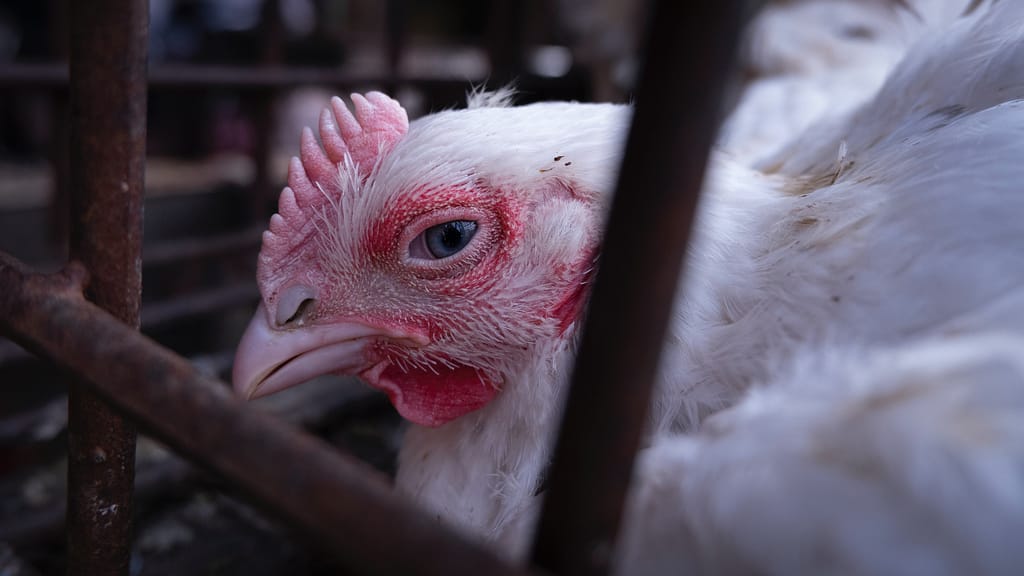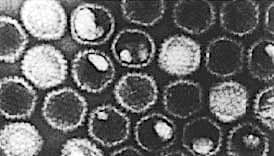
What is Marek’s Disease?
What is Marek’s Disease? Marek’s Disease is one of the most common illnesses occurring in chickens and other poultry. It is, however, also easily preventable in chickens if they are vaccinated against it and other safety measures are taken.
Marek’s Disease Virus (MDV) is a type of chicken herpes virus and avian cancer which often leads to tumors forming in your chickens as well as other health complications. While chickens are the poultry most likely to get the virus, it can also affect quail, turkeys, pheasants and other game fowl. It does not affect humans and other animals.
Like other similar herpes viruses, once a chicken has it, it will never go away and will often lead to health issues that result in death of the chicken. The disease is highly contagious and can affect any poultry not vaccinated against it.
It most often affects younger chickens between newly hatched chicks and grown chickens up to about a year old, but it can affect all of them (just not as high a percentage). The virus can stay alive in its environment for around a year and continually infect chickens in the area.
Other names for Marek’s Disease (MD):
- Fowl Paralysis (sometimes Range Paralysis)
- Visceral Leukosis
- Chicken Herpes
- The Chicken Disease
Transmission
The main way the virus is spread is through dander and dust shed by poultry, but it can also be found in feces from infected chickens. As other chickens breathe in the contaminated particles, they get the disease themselves.
The virus can spread quickly through a flock. This is one reason why it is suggested by vets and poultry keepers alike to keep new chickens separated a good distance from your main flock until you can be certain the new birds are not sick and you’re not introducing disease to your current healthy flock. However, chickens with the virus often will not show actual symptoms until after several months. This means the amount of time you need to keep your chickens separated might be much longer than you would like.
Not all chickens will die from Marek’s, and those that don’t will continue to be carriers for the remainder of their lives. To prevent healthy chickens from being infected, it is suggested to put down any infected chicken. If you are unwilling to euthanize your chicken, then they should be kept secluded away from the rest of your flock and you should make sure that all of your other chickens have received the vaccine. Please keep in mind it’s highly recommended by vets and poultry experts to humanely euthanize and remove infected chickens to prevent risk of the virus spreading.
Not all chickens infected with Marek’s will have symptoms. That’s why it’s important to use preventative methods, such as the vaccine, to ensure you never lose a chicken from your flock to Marek’s.
One plus, is that the virus cannot be spread to eggs. Even if the hen that laid the egg had the virus, the egg, and the chick that hatches from it, will not. Just make sure that the egg is incubated away from infected chickens and areas where they roam.

Symptoms
How do you know if your chicken has Marek’s?
There are multiple different strains & forms or Marek’s that also have different symptoms. Generally, the disease will affect the eyes, skin, nerves, and internal organs. Chickens will often show more than one form or symptom and the severity can vary from chicken-to-chicken. However, it may take several weeks to a couple months before an infected chicken starts showing any symptoms.
Marek’s that affects the eyes of chickens may result in a graying of the eyes (may look blue when they previously were not), deformed irises (smaller pupil, discolored), lesions, and/or blindness.
Chickens with the skin form of Marek’s might have external tumors and enlarged feather follicles which can lead to scabs and injuries.
Many chickens with Marek’s will grow tumors on their skin or throughout their nervous system and bodies. Common areas are on the head, neck, wings, legs, or internally around their organs. These tumors can lead to paralysis, inability to walk, lift their head, and/or breathe. All of these health difficulties can lead to rapid weight loss in chickens.
Other symptoms you may want to watch for are regular health issue symptoms such as lethargy, walking strangely (drunkenly), pale combs/wattles, dehydration (smaller, shrunken combs), low egg production (or no eggs), and unusual-colored diarrhea (sometimes green).
Affected birds will often pass away due to starvation since they are unable to move around and eat properly. Other causes of death are often due to injury by other chickens and animals or other complications caused by the virus.
Remember that it is also possible for a chicken with Marek’s to not show any visible signs of the disease and simply pass away.
Symptom Overview: graying eyes, eye lesions, blindness, tumors, paralysis (of neck, wings, legs), difficulty moving, difficulty breathing, weight loss.
Diagnosis
There is, unfortunately, no cure for Marek’s Disease once a chicken has it and with the slew of other diseases that might affect a chicken it can sometimes be difficult to diagnose yourself.
The best way to know is by bringing your chicken to an avian vet or by having a biopsy or necropsy performed on a sick chicken that has passed.
Prevention & Control
While Marek’s can be difficult to contain or control, it can be mostly prevented through vaccinations.
Marek’s Disease Vaccination (HVT)
The absolute best way to help prevent your chicken from developing the negative effects of Marek’s is by having them vaccinated as newborn day-old chicks. Doing so helps improve immunity and provide resistance to the disease and its symptoms before they have the chance to be in contact with other poultry who might be carrying it.
**NOTE** The Vaccine does not fully prevent the disease – especially in the case where a vaccinated chick is introduced to the disease before the vaccine has been able to take full effect. While the vaccine can help prevent the development of tumors, a chick might still carry and shed the disease infecting other chickens (the vaccine minimizes this though). This is why good biosecurity and other preventative measures are also very important.
From the time they’re vaccinated it takes a couple days to a week for the vaccine to fully work so it’s a good idea to keep new vaccinated chicks separated from your flock for at least a week before letting them get close. Although some sources say that newborn chicks have natural antibodies to the disease for the first couple weeks of their life – it’s better to use preventative measures as early on as you can rather than risk infection.
Many hatcheries offer vaccination services for relatively cheap, which may be worth it to you to avoid any potential issues.
You can also purchase a vial of the vaccine and administer it yourself; however, this is not recommended unless you are experienced and comfortable doing so. For one, the vaccine is very temperature sensitive and must be kept cold. If it gets too warm at any point, then it is no longer viable. The vaccine also comes in vials that contain 1,000+ doses worth (this is from a 200 mL bottle), so it’s not economical for most backyard chicken-keepers to purchase. You also have to be sure of the dosage amounts, cleanliness factors, etc.
That said, if you are interested in buying the vaccine and administering it yourself, it should come with explicit instructions on how to handle and administer the vaccine – these directions should be followed very carefully.
As long as the vaccine has enough time to works its way through your chicks’ systems, they should be protected from the virus.
There is also an ovo administration of the vaccination available which requires the vaccine to be injected through the egg itself (this one’s probably best left to professionals).
The vaccine itself generally contains live FC-126 strain of turkey herpesvirus which has been scientifically proven to prevent the disease in chickens (source: Marek’s Disease Vaccine (HVT) for Animal Use – Drugs.com)
Buy Chickens from Trustworthy Sources
Only buy your chickens from a hatchery or breeder you can fully trust and know is well-informed on poultry and their health.
Avoid cross contamination
Even if you’re keeping your flocks separated to ensure there’s no spread of disease, you yourself are most likely going back and forth between the flocks and there’s a chance that contaminated dust could be on your hands and clothes and spread from you from one flock to the other. If you have a cat or dog that hangs out with your animals, they could also cause a cross-contamination issue.
To take care to keep infected or potentially infected birds completely separate from all other animals and make sure you wash your hands or change your clothes (including shoes) in between taking care of them.
You could also have 1 member of your family be in charge of one flock while someone else is in charge of others. If you have young chicks that are vaccinated, you should take care of them before taking care of your older flock.
Maintain Health & Reduce Stress
Feeding your chickens a balanced diet and making sure they have the right nutrients can help keep them healthy and more resistant to disease.
Stress can lead to lower immunity to diseases such as Marek’s so it’s a good idea to prevent your chickens going through as much stress as you can. Ensuring your chicks are kept at proper temperature; have adequate ventilation; access to clean food, water, and bedding; and are not over-crowded will help ensure they have minimal stress.
Maintain Good Hygiene
Good hygiene such as keeping bedding, coops, food, and water clean will help prevent spread of Marek’s as well as other diseases and illnesses. However, remember that Marek’s is spread through dust and dander, so cleanliness will only help, but not fully prevent since chickens, by nature, are dusty animals.
What to do if you have a Marek’s Disease breakout?
Separate chickens that are showing visible signs away from chickens that currently look healthy (and are potentially not infected yet, or at least not showing signs).
Deep clean and disinfect your coop, run, and other areas where your chickens might roam.
If you’re sure your chickens are infected with Marek’s you should euthanize them to prevent further spread.
Seek veterinary help. A vet will be able to perform a biopsy or necropsy on a chicken and testing can tell if they do indeed have the virus.
Continue to monitor your other birds for signs. Don’t introduce new chickens until you’re sure conditions are safe.
Commonly asked questions w/answers
Q: Can Marek’s spread from my chickens to other animals or to humans?
A: Marek’s cannot spread to humans or most animals. There are some other poultry such as quail, turkeys, and game birds that can get the virus, but it’s not spread to them as easily as it is with chickens.
Q: Can Marek’s be cured?
A: Unfortunately, it cannot be cured, only prevented with the vaccine, good hygiene, and biosecurity.
Q: Is the Marek’s vaccine dangerous for my chickens?
A: The vaccine is perfectly safe for your chickens, even newborn chicks. The only time they might be in danger is if the vaccine is being administered by someone who is not a professional or doesn’t know how to safely administer the vaccine, or if for some reason there is a contamination issue (unclean needle, hands etc).
Q: Does the vaccine contaminate chicken meat or eggs?
A: While contaminate might not be the right word for it, it is recommended to not butcher a chicken or eat their eggs until around at least a month has passed since they received the vaccination. If you’re getting your day-old chicks vaccinated, then this shouldn’t be a problem for you.
Here are some other sources regarding Marek’s Disease on the web:
The American Association of Avian Pathologists (AAAP) Avian Disease Manual: https://www.aaap.info/avian-disease-manual-old-edition#calibre_link-1
Wikipedia Article “Marek’s Disease” https://en.wikipedia.org/wiki/Marek%27s_disease
